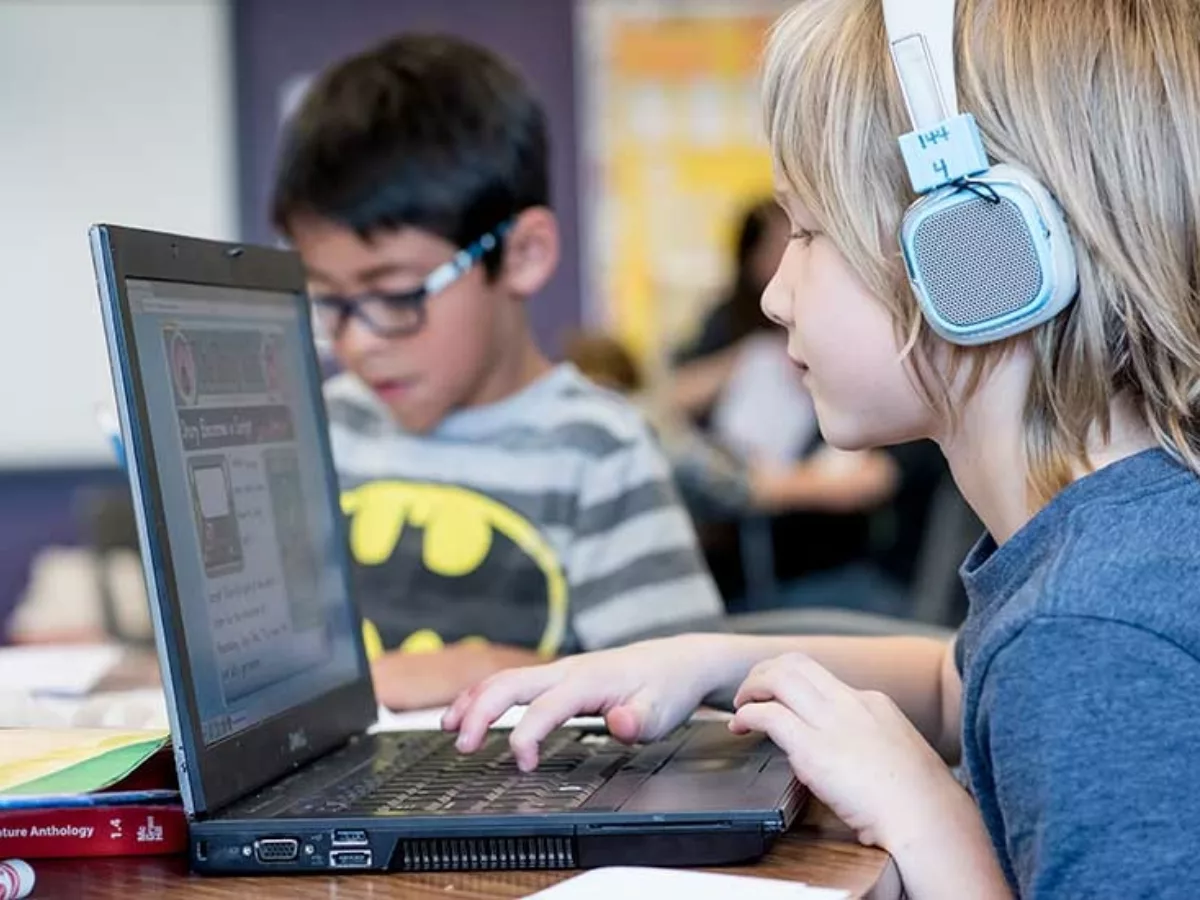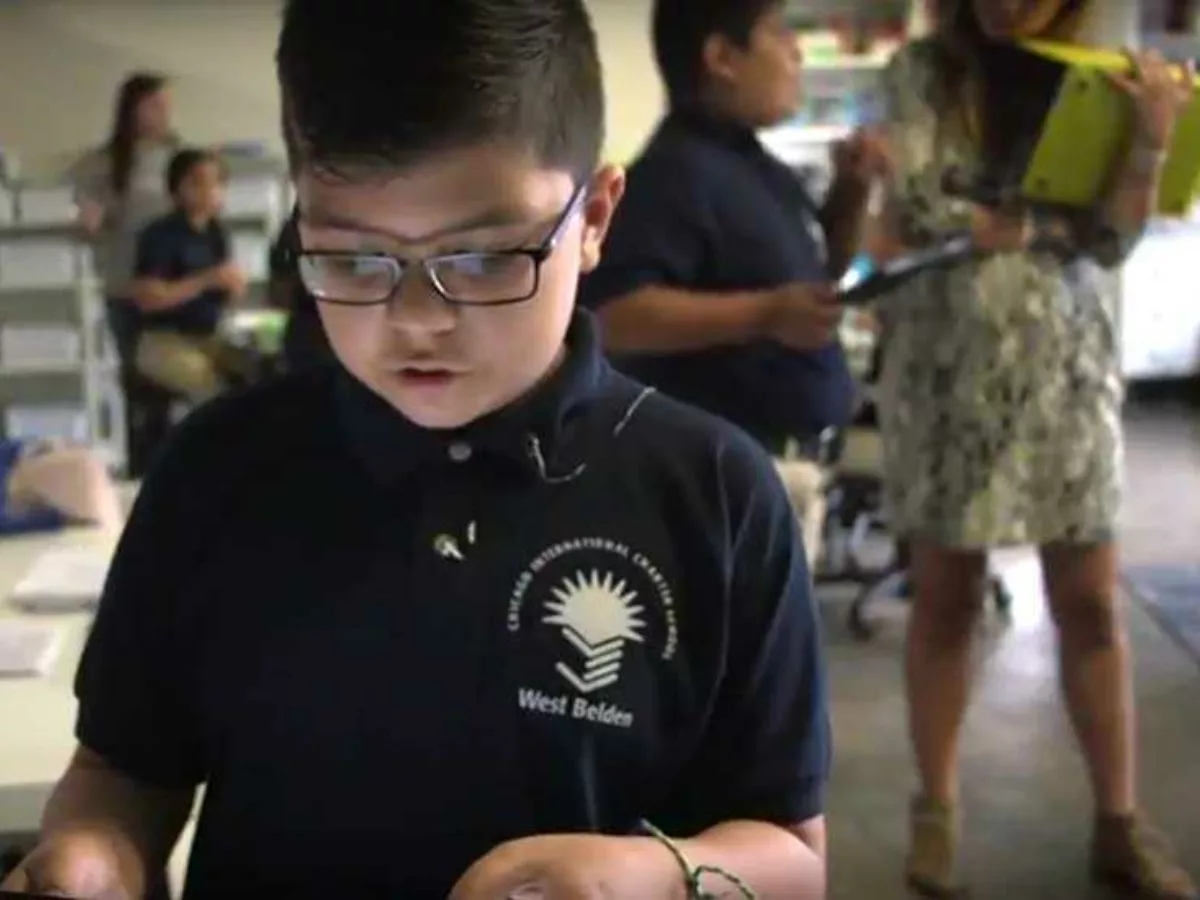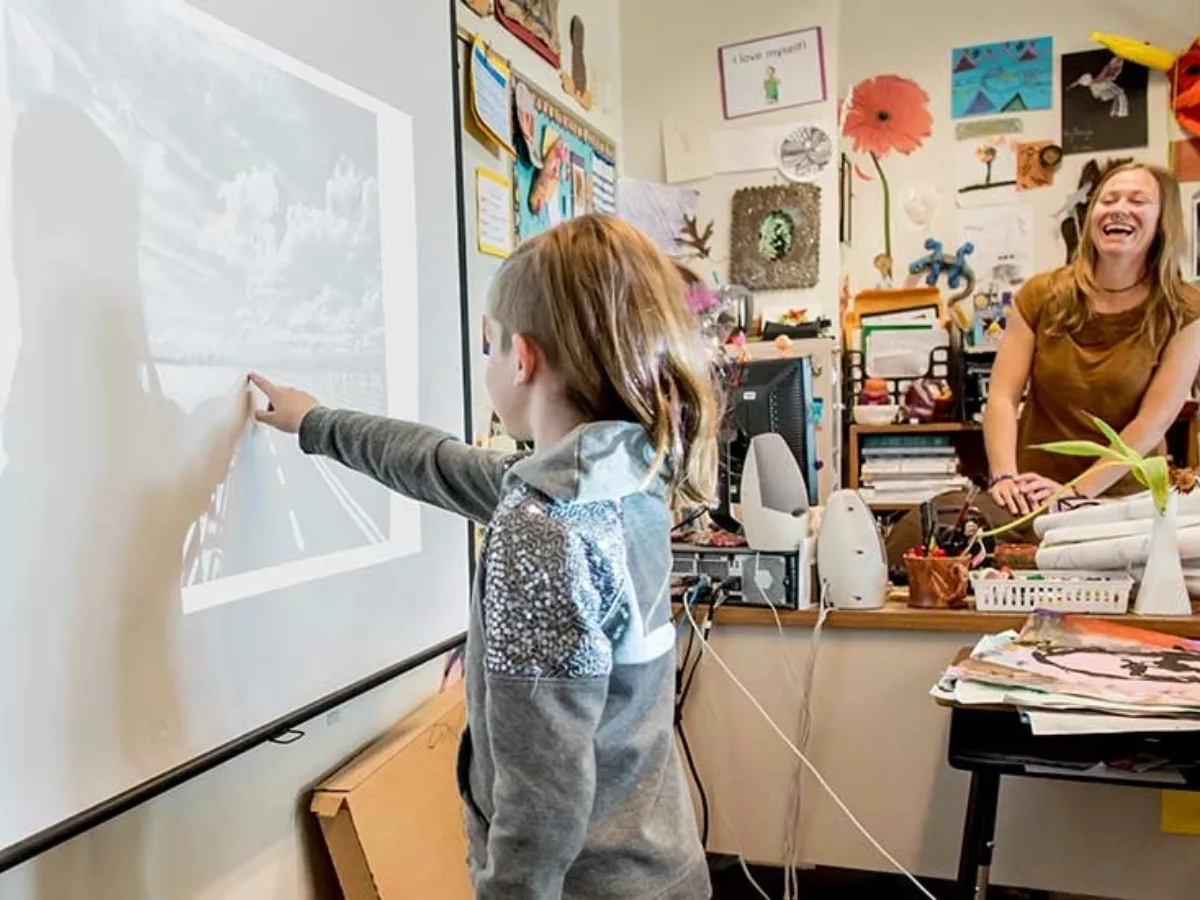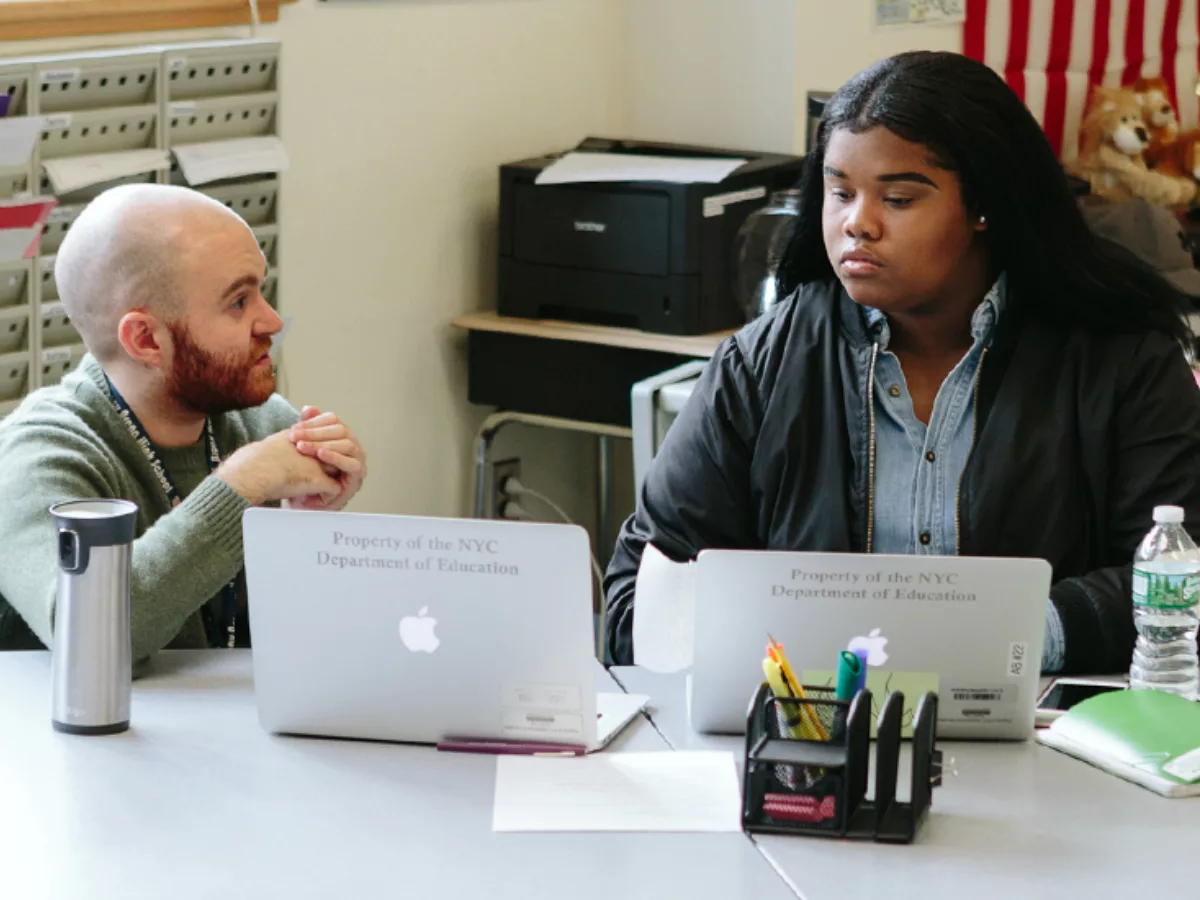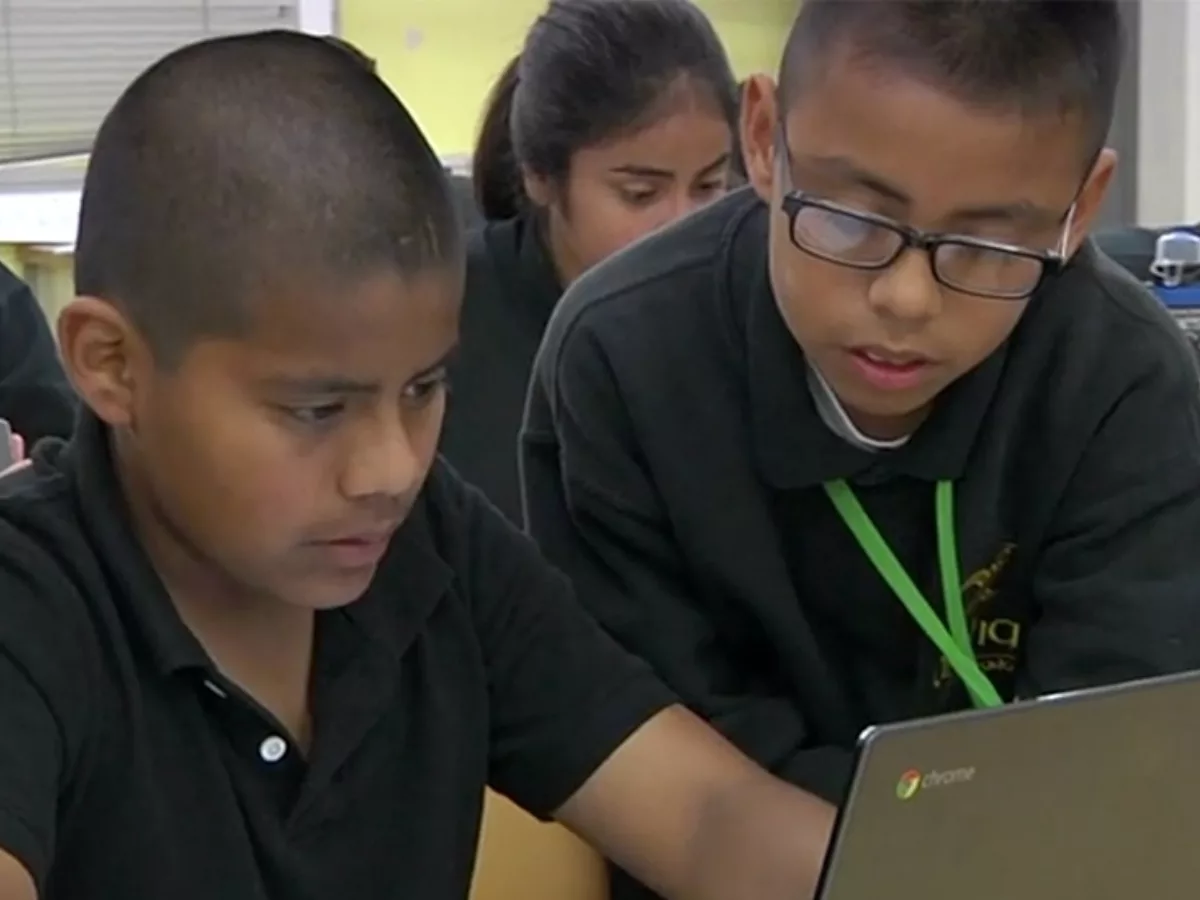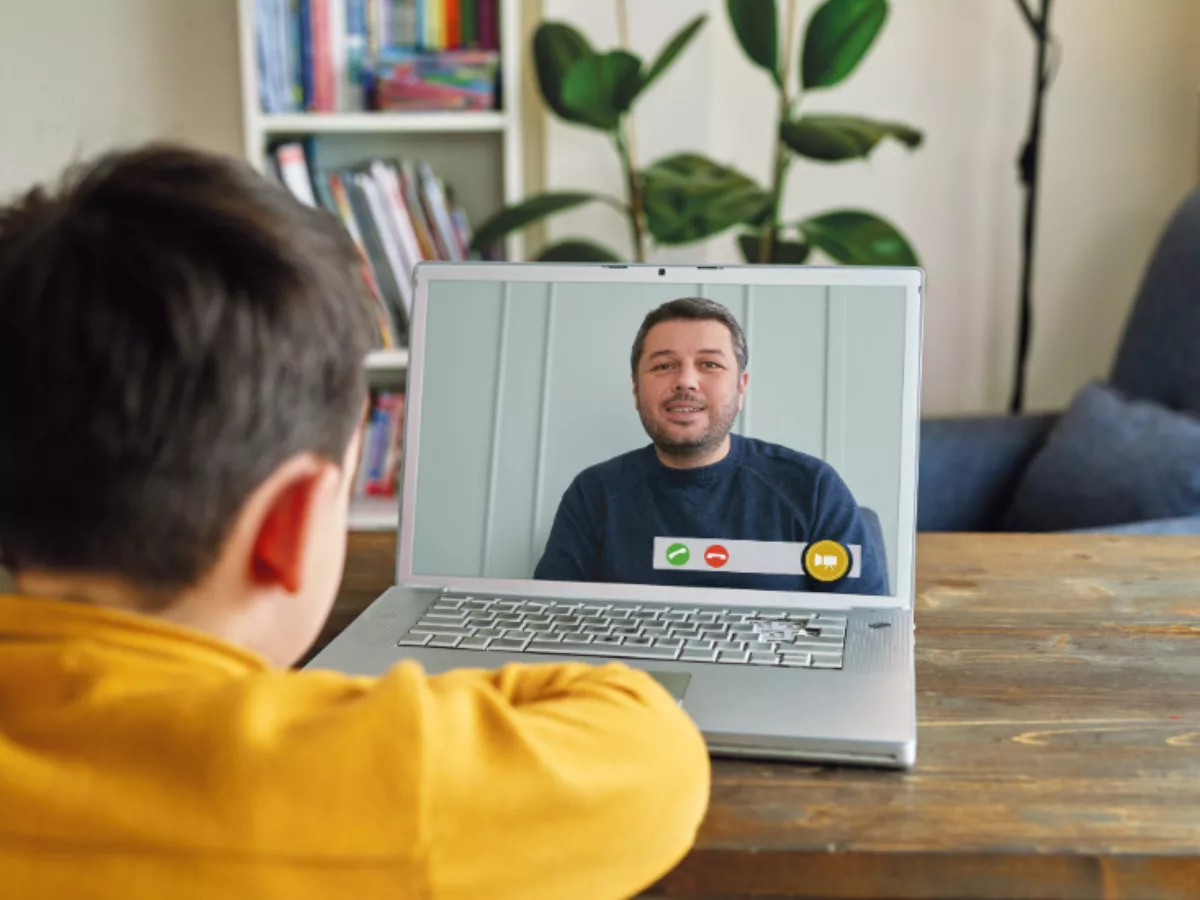Digital Equity in the Classroom
Considerations to support digital equity into the classroom
In our urgency to remove barriers to digital equity, conversations often start with the “boxes and wires” of technology itself. However, even if every student (and their family) gains equitable access to powerful devices and high-speed internet, differences will persist in how students within and across different classrooms, schools, and systems use technology for learning. These differences – where some students use technology to deepen learning through critical analysis and demonstrate knowledge through creation, while others passively consume content and complete what amounts to digital worksheets – result in a pervasive Digital Use Divide.
Focusing first on students – specifically, what we want them to experience and why – presents a better starting point for communities. TLA believes that every student should engage with high-quality learning experiences that are personalized to their unique needs, strengths, interests, and identities. Considering the exponential rate at which technologies evolve, preparing students to fully participate in our society, democracy, and economy requires opportunities to powerfully use technology in service of learning.
Technology and the internet have long been heralded as a democratizing force; yet, even though many schools now have equal access to technology, students experience vastly different realities. Even when students have access to the same technologies, their experiences may vary depending on systemic barriers as well as individual teachers’ knowledge, instructional practices, and/or biases.
This well-documented Digital Use Divide persists between students who use technology in active, critical, and creative ways and those whose experiences are limited to more passive expectations. It disproportionately impacts students who reside in lower-income communities and, relatedly, communities of color. In these instances, students are more likely to interact with technology for content acquisition, “drill-and-skill” programs, remediation, and test preparation rather than in creative and transformative ways.
This section highlights skills and strategies that encourage students to engage in a variety of practices that are targeted, relevant, actively engaging, socially connected, and growth-oriented to build critical competencies for a digital world (e.g., critical media analysis, multimedia creation, real-world data collection, connections with experts or peers beyond the classroom, and authentic opportunities to share learning with broader audiences). It also demonstrates how technology can create opportunities that might not otherwise be possible.
For each focus area, you will be guided through three steps to ensure you understand what digital equity looks like in action and how to implement changes in your own school or system.
Step 1: Where are you currently? Where do you want to go?
From a digital equity perspective, identify where some of your schools or classes might exist on a continuum, ranging from Foundational to Advanced, using the Self-Assessment Tool.
Step 2: What is needed to make hops, skips, or leaps towards improvement?
When working through the questions in the Reflection and Planning Workbook, think about your current context; this could focus on a specific school or even your district as a whole. What systems, structures, or processes would allow you to make at least an incremental change towards more advanced practices? Remember that digital equity is an ongoing and iterative process. Initially, you may not be able to answer all of these questions.
Step 3: What does it look like in practice? How can you implement similar practices in your school or system?
After exploring different strategies, the Reflection and Planning Workbook will prompt you to consider and evaluate WHO needs WHAT to learn HOW.
A true indicator of digital equity is the reality of every student having real-time access to and interaction with materials and experiences that are tailored to their unique needs, strengths, interests, and identities (individual and cultural).
With digital content, students can learn from multiple perspectives beyond traditional texts, through a number of different modalities such as audio and video, and in an accessible way. Strategies include differentiation and intervention, alongside ensuring that students engage with rigorous grade- and group-level learning experiences.
What might this look like in action? Here are two concrete examples.
Strategy 1: Virtual Notebooks
With virtual notebooks, students can access content using multiple modalities and take advantage of digital tools that offer capabilities for speech-to-text, text-to-speech, translation, and word prediction. From a digital equity perspective, virtual notebooks allow students to capture and access their learning in a way that is most relevant to them.
- WHO: For many students, traditional organization systems such as physical notebooks and binders can be disorienting as they lack search functionality and the capacity to be accessed from multiple places. These systems also lack digital accessibility features, making learning particularly difficult for students with diverse learning needs.
- WHAT: Virtual notebooks offer supports for all students by helping them to organize learning tasks, access learning materials from any location, and engage with content in ways and at times that best support their learning preferences and needs.
- HOW: Students can engage with learning materials and tasks at their own pace. Because they have access to the full agenda and learning goals, students can better understand what is expected of them, complete tasks at their own pace, and ask for help. In a digital format, they can also customize their notebooks to best meet their learning needs and preferences.
Strategy 2: Personalized Student Learning Plans
With virtual personalized learning plans, students can access learning materials from any location and engage in digital experiences that are engaging and effective, allowing them to learn in ways that are meaningful, targeted, and relevant. From a digital equity perspective, virtual personalized student learning plans can be adapted to accommodate students’ preferences and identities, and they can help ensure that students have access to a variety of digital tools, devices, and learning materials that are tailored to their individual needs.
- WHO: General learning plans are often designed to be “one-size-fits-all,” but for students with unique learning needs, common learning materials, tools, and modalities may prove to be ineffective. Particularly in learning environments that oscillate between synchronous and asynchronous instruction, a general plan for instruction may exacerbate certain students’ challenges as well as impede engagement and participation.
- WHAT: Virtual personalized learning plans are digital guides that offer students a variety of choices through which they can explore subject matter and content. By utilizing data and insights related to students’ individual learning needs, content-development needs, language development needs, and interests, these personalized plans can be designed to adjust learning activities, assessments, and instruction in a manner that best supports individual students.
- HOW: Virtual personalized learning plans can be adapted and adjusted to accommodate students’ varying preferences. Customizing each plan may also decrease the possibility of students finding themselves disengaged or ‘lost’ in virtual learning environments because their unique needs are being met, they know where to find learning materials, they can keep track of their progress, and they can leverage a host of digital tools for help. This experience also provides students with a sense of ownership and agency over their learning.
Leadership Action Steps
Step 1: Where are you when you think about targeted and relevant practices from a digital equity perspective?
Use the Targeted and Relevant section of the Self-Assessment Tool to gauge your progress.
Step 2: What’s needed to make hops, skips, or leaps towards improvement?
With your team, review the Reflection and Planning Workbook Questions on page 3.
Step 3: What can digital equity look like in a targeted and relevant classroom? How can you do this in your specific school or system?
Every student experiences learning in a unique way. When considering targeted and relevant practices from a digital equity perspective, it is important to return to the essential question: WHO needs WHAT to learn HOW.
You’ve seen two examples of strategies above, and you can explore a few more below. These strategies are just the tip of the iceberg, and we suggest teams spend some time on our Targeted and Relevant Strategies page to explore others.
With new ideas in mind, navigate to page 4 in the Reflection and Planning Workbook and consider the unique language, accessibility, motivational, and social needs of the students in your context (WHO). From a digital equity perspective, WHAT changes might you recommend to make learning more targeted and relevant, and HOW might it improve their learning?
Experiences that are actively engaging can address a key barrier to digital equity: digital use. The recent 2024 National Education Technology Plan (NETP) highlights how digital technologies have the potential to create previously unimaginable learning opportunities – but only when paired with an understanding of how learning could and should look different. From multimedia tools to generative AI, bridging the digital use divide requires that students be empowered to use various technologies to actively, creatively, and critically engage with content, communicate their thinking, share their learning, and create new knowledge.
Simply providing lower-income students access to technology – computers, game-authoring software, graphics applications – was an indicator of achievement. By emphasizing the acquisition of tech over the acquisition of high-quality instruction, the class was simply not built to deliver a robust STEM learning experience… Curriculum-poor classrooms severely restrict the ability of students to develop the full range of skills that adequately prepare them for postsecondary education and an economy that values higher-educated and higher-skilled persons.
”
S. Craig Watkins & Alexander Cho
The Digital Edge: How Black and Latino Youth Navigate Digital Inequality
When digital equity is fully realized:
Students have multiple pathways to engage and create in ways that are meaningful to them.
Classroom practices account for the reality that students come into classrooms with varying digital and media literacy skills. Teachers cannot assume that all students are comfortable with and knowledgeable about learning with technology.
Students have the ability to apply and reflect on their learning deeply and authentically in new ways, on new platforms, and with new audiences.
Instruction, devices, and materials should aim to build students’ confidence and capabilities to autonomously use technology both inside and outside of the classroom. This is known as digital agency.
To understand what this may look like in your context, explore the two strategies below.
Strategy 1: Digital Demonstrations
Technology offers students tremendous variety in how they can both express themselves and demonstrate their learning. When considering digital equity, this means that students have both the access and the opportunity to use technology in ways that support them as learners, honor their thinking and perspectives, and give them opportunities to actively engage in the process.
- WHO: All students should have opportunities to demonstrate their understanding in ways that honor their identities and learning preferences while meeting the demands of rigorous criteria. Traditional assessments can deliver on the goal of capturing and reflecting students’ learning but may exclude key elements related to how individual students are uniquely engaging with content.
- WHAT: Digital demonstrations allow students to show or apply their learning by creating digital work products that offer more functionality and capacity than traditional, paper-based assignments.
- HOW: This practice allows students to show their thinking in ways that are engaging, motivating, and creative. Digital demonstrations accommodate varying levels of familiarity and comfort with technology while providing the opportunity to reflect on learning in ways that truly connect with students’ understanding, voice, and learning preferences.
Strategy 2: Video Pairing
Video is often incorporated as a tool to supplement and provide instruction. When used with digital equity in mind, students control the pace of their learning and can leverage features like closed-captioning or translation to support their comprehension. Although the use of video alone often presents a relatively passive experience for students, when paired with additional activities such as reflection guides, creative assignments, or other checks for understanding, students can become more actively engaged in their learning.
- WHO: Many students prefer video because they can learn at their own pace by pausing, rewinding, or even fast-forwarding. Assuming sufficient technology access, students can choose when, where, and how they might engage with these videos. Given the wealth of video available, educators also have the opportunity to choose content that reflects students’ interests and identities.
- WHAT: Video supports students by providing an organized and interactive approach to reviewing and engaging with multimedia learning content. The key to making this activity interactive is to provide opportunities for reflection throughout the video using checks for understanding, opportunities for reflection, or embedded content.
- HOW: In addition to watching the video, students respond to questions, prompts, or activities using various modalities such as audio, video, and text. By integrating this strategy, teachers create more active learning experiences and make their content more universally accessible.
Leadership Action Steps
Step 1: Where are you when you think about actively engaging practices from a digital equity perspective?
Go to the Actively Engaging section of the Self-Assessment Tool and think about how you want your students to interact with the available technology, tools, and digital materials.
Step 2: What’s needed to make hops, skips, or leaps towards improvement?
With your team, review the Reflection and Planning Workbook Questions on page 5. Make sure to also consider the digital literacy skills of your teachers. Given the iterative nature of digital equity, substantial changes in classroom practice may take time depending on the culture and level of comfort with technology in your school or district.
Step 3: What does digital equity look like in an actively engaging classroom? How can you do this in your school or system?
Every student experiences learning in a unique way. The two strategies above illustrated what this looks like in practice, and we’ve provided a few more below. You might also explore additional strategies to support actively engaging practices on our site.
Once you’ve explored potential strategies, go to page 6 in the Reflection and Planning Workbook and consider the unique language, accessibility, motivational, and social needs of the students in your context as well as their digital literacy skills (WHO). From a digital equity perspective, WHAT changes might you recommend, and HOW might they lead to more actively engaging learning experiences?
When learning experiences are socially connected, students make meaningful, supportive associations with teachers, experts, peers, and the content of their learning. Within the context of digital equity, students should be able to leverage technology to: collaborate with peers, teachers, family members, community members, and even experts in the field; explore their interests; and engage with content in meaningful, relevant ways.
High-quality, socially connected learning experiences can provide students with a foundation for their roles as digital citizens, access to social-emotional supports, and opportunities to interact with experts and resources from any location. When students lack sufficient digital tools and internet access, they are robbed of both socially connected learning experiences and social-emotional support such as opportunities to connect with teachers for help or to build support systems with peers. Additionally, today’s increasingly digital world demands that students develop the skills and competencies to collaborate effectively in both physical and digital environments. Finally, to ensure that all students have the opportunity to be inspired and engaged in learning experiences to develop critical computational skills, their interests, identities, and cultures should be embraced and validated. As described by the Kapor Center’s Culturally Responsive-Sustaining Computer Science Education Framework, students need opportunities to develop strong identities with a deep understanding of technology’s purpose, potential, and impact.
To understand what this may look like in practice, consider the two example strategies below.
Strategy 1: Teach-Back Tuesdays
By using asynchronous video to teach an academic concept or skill to any audience that they choose, students gain a sense of agency as they actively engage in the learning process and an opportunity to experience socially connected learning. From a digital equity perspective, asynchronous video also creates a more mistake-tolerant environment for students who may otherwise be reluctant to share their learning as it gives them multiple “takes” without penalty – while still allowing them to connect with a broader audience.
- WHO: Students may have varying interests and comfort levels with sharing their learning publicly. Using asynchronous video in this strategy allows them to choose their audience and removes the pressure of a “live” performance.
- WHAT: Combining video with an opportunity to share learning with the broader community deepens family engagement, extends communication to new channels, and can support peer learning.
- HOW: Each week, students create a new video teaching a different concept or skill to an audience of their choosing. Whether producing a video for a family member or a peer, students have an authentic opportunity to share their learning and deepen their understanding of how to successfully build social connections through technology.
Strategy 2: Community Partnerships for Career-Oriented Learning Work
Career-oriented partnerships allow students to develop concrete understanding of how the real world leverages digital literacy skills and concepts. During the pandemic, students learned to make meaningful connections with experts and community members through a variety of online channels and tools. Engaging in these partnerships created opportunities for students to authentically learn about different careers and to develop critical communication and collaboration skills.
- WHO: Students have varying understanding of career opportunities as well as the types of digital literacy skills that can help them be successful when communicating and collaborating with experts and community members.
- WHAT: Community partnerships can help students make authentic connections between their academic work and the real world. These career-oriented learning experiences enrich understanding of content and provide opportunities for more socially connected learning.
- HOW: Teachers helped to connect what students were learning with partners in the field through expert interviews and opportunities for co-creation. These experiences provided students with a chance to engage in projects with potential future careers in mind.
Leadership Action Steps
Step 1: Where are you when you think about socially connected practices from a digital equity perspective?
Go to the Socially Connected section of the Self-Assessment Tool and think about the ways in which your students engage in peer learning, relationship-building, and connecting with the broader community.
Step 2: What’s needed to make hops, skips, or leaps towards improvement?
With your team, review the Reflection and Planning Workbook Questions on page 7. Make sure to also consider the digital and media literacy skills of your teachers and students as well as how you address digital citizenship.
Step 3: What does digital equity look like in a socially connected classroom? How can you do this in your school or system?
A socially connected classroom encourages students to make meaningful, supportive connections with classmates, teachers, community members, and experts to deepen their understanding of content and curricula. Beyond the strategies described, we’ve added a few more below.
For more ideas about what this could look like, explore these additional Socially Connected strategies, and then go to page 8 in the Reflection and Planning Workbook. Make sure to consider your students’ digital literacy skills, social-emotional needs, and interests in the community (WHO). From a digital equity perspective, WHAT changes might you recommend to create new learning experiences, and HOW might those changes support more socially connected opportunities?
Growth-oriented instruction facilitates personalized and mastery-based learning experiences. From a digital equity perspective, this means that all students should have access to the technology and tools that enable them to take ownership of their learning, understand their progress, and take steps to acquire essential skills and competencies.
Modern technology can adapt and adjust to support varying levels of content mastery, identify learners with unique literacy or cognitive capacities, and provide targeted support such as intelligent tutoring to enable independent practice and skill-building. From the use of digital tools and platforms that allow students to choose their own learning journeys to online tutoring facilitated by artificial intelligence, these technologies exemplify promising opportunities to deliver personalized learning at scale.
Technology offers a variety of growth-oriented learning opportunities that can enhance personalized learning. However, digital equity requires that leaders and educators evaluate the effectiveness and appropriateness of technology based upon whether or not:
- all students have equitable access from school and at home,
- the tools can adapt to meet and fit the needs of all learners, and
- potential bias has been mitigated both in the content and the algorithms.
The two sample strategies below illustrate ways in which digital equity supports growth-oriented learning experiences.
Strategy 1: Student Choice Over Path, Place, and Modalities
When supported by digital technology, students are no longer constrained by sequential learning experiences that require linear progression within a designated amount of time. If students have equitable access to devices and high-speed internet, then they can choose what they are learning, when, and in what manner. Digital planners, task lists, and content repositories can give students agency over their own learning and facilitate growth-oriented practices.
- WHO: Depending on their prior experiences, learning preferences, digital literacy skills, interests, and context, students need diverse entry points into learning experiences as well as varying opportunities to demonstrate their proficiency and competency.
- WHAT: Leveraging technology to increase choice over path, place, and modality supports growth-oriented learning for all students. Technology could include task lists and planners as well as adaptive platforms that present experiences that meet students’ immediate needs.
- HOW: Teachers can create conditions that allow students to choose the sequence, pace, and modality of learning. Rather than creating ambiguity, teachers provide students with clarity about which learning activities must be completed based on analysis of diagnostic assessments. They also prompt students to monitor their own progress and scaffold how they make decisions about their learning.
Strategy 2: Customized Learner Pathways
Self-paced, choice-based learner pathways present students with a variety of learning tasks that may include online content and creation opportunities, paper-based practice, group collaboration, and rigorous performance tasks. Designed by teachers to exist within a common digital platform, these pathways encourage student agency and autonomy while taking advantage of accessibility features, multiple modalities, and applications that may be adaptive or intelligent. In this instance, digital equity implies that students can access the pathways from multiple contexts and actively engage with targeted and relevant digital materials to proceed at their own pace.
- WHO: All students can benefit from customized learner pathways. However, they can be especially helpful for students receiving special education services or who have individualized education plans or accommodations. Because the pathways can be completed asynchronously, students can take as much – or as little – time as they need. They also benefit from multiple modalities, accessibility features, and more inclusive learning experiences as pathways do not have to be completed in a linear fashion.
- WHAT: Teacher-designed pathways housed in a central digital repository such as a learning management system (LMS) like Google Classroom present opportunities for students to pursue specific competencies, performance indicators, and learning targets.
- HOW: As students progress through the pathways, they demonstrate their progress through a number of performance tasks, collaborative projects, one-to-one conferences, or small-group instruction. Along the way, students have agency over how and when they complete each pathway.
Leadership Action Steps
Step 1: Where are you when you think about growth-oriented practices from a digital equity perspective?
Digital equity ensures that the selected technologies enable success and facilitate mastery for all students. Use the Growth Oriented section of the Self-Assessment Tool to consider how your students might engage with platforms, tools, and software that adapt to meet their needs, help them monitor progress, and/or support their acquisition of new knowledge and skills.
Step 2: What’s needed to make hops, skips, or leaps towards improvement?
With your team, review the Reflection and Planning Workbook Questions on page 9.
Step 3: What does digital equity look like in a growth-oriented classroom? How can you do this in your school or system?
Growth-oriented practices allow students to progress through standards and competencies at their own pace and in a way that best fits their unique needs and preferences. To understand how digital equity supports growth-oriented learning, explore more strategies below or on our Resources and Guidance site before returning to page 10 in the Digital Equity Audit.
Consider the unique language, accessibility, motivational, and social needs of the students in your context as well as their digital literacy skills (WHO). From a digital equity perspective, WHAT changes might you recommend to create new pathways for learning, and HOW might those changes support more growth-oriented practices?
Once you have completed this section, move onto “Essential Conditions to Support Digital Equity.”

